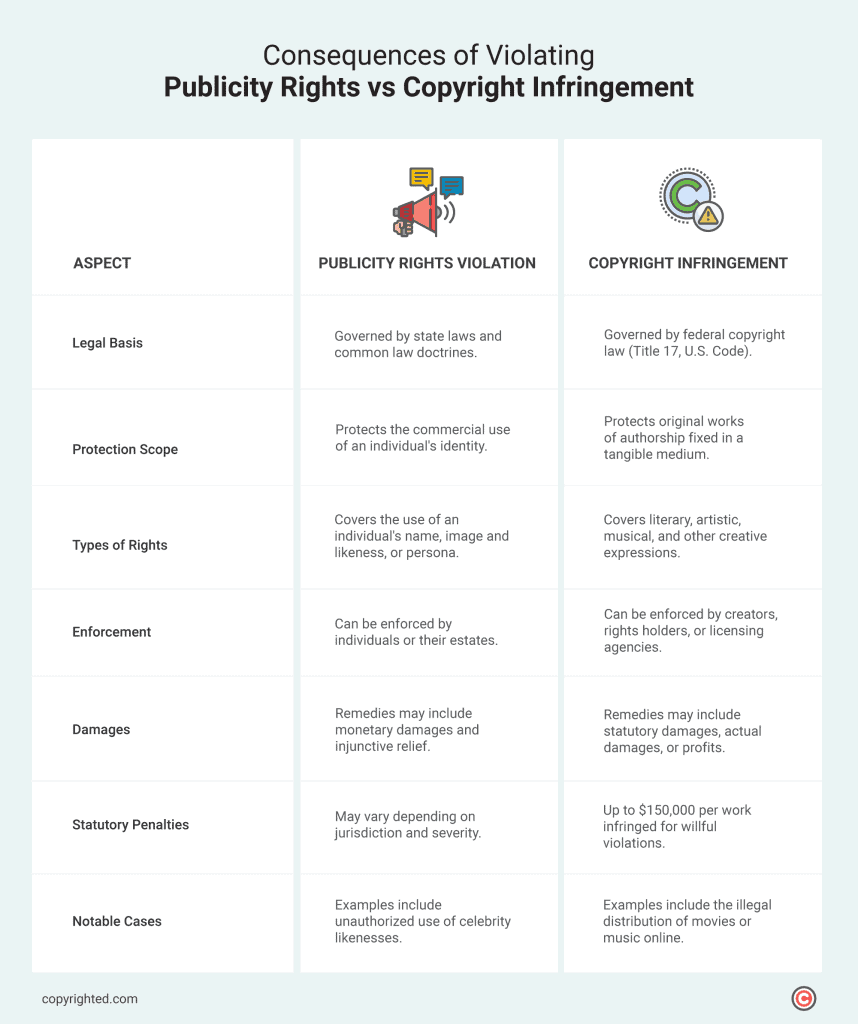Copyright and publicity rights are integral components of intellectual property law, playing crucial roles in protecting the interests of creators and individuals in the modern era.
Copyright refers to the legal framework granting exclusive rights to creators over their original works, ensuring they have control over their creations’ reproduction, distribution, and adaptation. On the other hand, publicity rights, also known as the right of publicity, pertain to individuals’ ability to control the commercial use of their name and likeness, or other recognizable aspects of their identity.
Understanding the definitions and significance of both copyright and publicity rights is essential for ensuring fair recognition and compensation for creators and protecting individuals’ reputational interests.
In this article, we delve into the definitions and importance of copyright and publicity rights, highlighting their differences, roles, and how they protect personal identity in various contexts.
- In terms of intellectual property law, two key concepts govern the use and protection of creative works: publicity rights and copyright.
- Copyright protects creative works, while publicity rights center on protecting an individual’s identity and likeness from unauthorized commercial use.
- Copyright and publicity rights intersect when creative works include recognizable individuals, like celebrities or public figures.
Table of Contents
Consequences of Violating Publicity Rights vs Copyright Infringement
In terms of intellectual property law, two key concepts govern the use and protection of creative works: publicity rights and copyright.
Publicity rights protect individuals’ control over the commercial use of their identity. In contrast, copyright law protects original creative works fixed in tangible forms, granting creators exclusive rights.
While both offer legal protections, the consequences for violating each can vary significantly. This comparison table explores the distinct outcomes of violating a person’s right of publicity versus copyright infringement, shedding light on their unique legal frameworks, penalties, and remedies.

The Intersection of Copyright and Publicity Rights

The intersection of copyright and publicity rights often arises in situations where creative works incorporate or depict identifiable individuals, such as celebrities, public figures, or even private individuals.
When both copyright and publicity rights are implicated, legal challenges arise that require a balance between the rights of creators to express themselves and the rights of individuals to control the commercial use of their identities.
Central to this balance is the consideration of transformative use – a core principle in copyright law that allows for the use of copyrighted materials in transformative ways, such as parody, commentary, or criticism. However, applying this doctrine can become intricate when it intersects with publicity rights, as courts must discern whether the use of an individual’s likeness constitutes transformative expression or unauthorized exploitation.
Adding to the complexity is the right of publicity law, which provides individuals with the exclusive right to control the commercial use of their identity, including their name, image, likeness, or other recognizable aspects. Violation of the right of publicity can lead to legal action, further complicating cases that involve both copyright and publicity rights.
Moreover, the First Amendment protection of free speech and expression introduces another layer of complexity. Courts must balance the interests of creators and the public’s right to access and engage with creative works against individuals’ rights to control the commercial use of their identities.
In certain cases, disputes over creative content can raise broader concerns over copyright censorship, especially when takedown actions are perceived to limit artistic or journalistic expression. These concerns underscore the importance of clearly distinguishing between the rightful protection of intellectual property and the suppression of lawful creative content.
The challenges are compounded by variations in copyright and publicity rights laws across jurisdictions, both within the United States and internationally. Discrepancies in statutory law, case law precedents, and cultural norms can significantly impact the outcome of cases concerning the intersection of these rights.
In handling these legal complexities, courts must carefully weigh the competing interests, considering the work’s transformative nature, commercial intent, and broader public interest.
Here are a few common scenarios where both rights are implicated:
Biographical Works
Biographies, documentaries, or fictionalized accounts of real-life individuals may involve the use of copyrighted materials such as photographs, film footage, or written works. At the same time, these works also depict the likeness and persona of the individuals involved, potentially implicating their publicity rights.
Commercial Endorsements
When celebrities or public figures endorse products or services, their likeness and persona are often used in advertisements or promotional materials. These endorsements can involve copyrighted content, such as photographs or video footage, creating a crossover between copyright and publicity rights.
Parodies and Satire
Parodies and satirical works often rely on recognizable figures or characters for comedic effect. While these works may be protected under copyright law as transformative creations, they also involve the use of individuals’ likenesses, raising questions about the balance between freedom of expression and the right to publicity.
Artistic Representations
Artistic works, including paintings, sculptures, and digital art, may incorporate depictions of real-life individuals. These representations can blur the lines between copyright and publicity rights, especially if the artwork is intended for commercial purposes or public display.
Preventive Measures and Best Practices
Intellectual property law requires a multi-faceted understanding of preventive measures and best practices for artists, content creators, businesses, and marketers alike. By proactively addressing potential legal challenges and adhering to industry standards, you can protect your creative works and mitigate the risk of copyright infringement or publicity rights violations.
Artists and Content Creators
As artists and content creators, protecting your intellectual property is important to preserving the value of your work and ensuring fair recognition and compensation. Understand your rights by familiarizing yourself with copyright law and publicity rights.
Keep detailed records of your creative process and consider using copyright notices to assert your rights. You can also explore licensing options to grant permission for others to use your work under specified terms and monitor online platforms for unauthorized use, taking prompt action to enforce your rights when necessary.
Businesses and Marketers
For businesses and marketers, respecting intellectual property rights is essential to maintaining brand integrity and avoiding costly legal disputes. Educate your team on copyright and publicity rights, obtain proper permissions when using third-party content, and secure clearances for endorsements or collaborations with individuals to prevent unauthorized use of their names.
Review contracts carefully, especially regarding ownership and licensing of intellectual property, and monitor social media channels for potential infringements, responding promptly to any issues that arise.
Legal Advice and Consultation
Seeking legal advice and consultation from qualified intellectual property attorneys can provide invaluable guidance and support in the face of legal issues. Choose a specialized attorney with expertise in intellectual property law, assess your specific legal needs, and explore alternative dispute resolution methods when appropriate.
It’s also important to stay informed about developments in intellectual property law and regulations and establish a trusted relationship with your attorney to receive ongoing support and guidance in managing intellectual property issues effectively.
Frequently Asked Questions
What are publicity rights?
Publicity rights, also known as the right of publicity, give individuals control over the commercial use of their name, image, likeness, or other recognizable aspects of their identity.
Why are copyright and publicity rights important?
Copyright and publicity rights are important for protecting the interests of creators and individuals, ensuring fair recognition, compensation, and control over their creative works and personal identity.
How do copyright and publicity rights differ?
Copyright focuses on protecting creative works, while publicity rights center on safeguarding an individual’s identity and likeness from unauthorized commercial use.
What are the consequences of violating copyright and publicity rights?
Consequences may include legal action, monetary damages, injunctive relief, and reputational harm for violating copyright and publicity rights.
What preventive measures can businesses take to avoid copyright and publicity rights violations?
Businesses can educate their teams, obtain permissions for third-party content, review contracts carefully, monitor social media, and seek legal advice and consultation to prevent violations of copyright and publicity rights.


